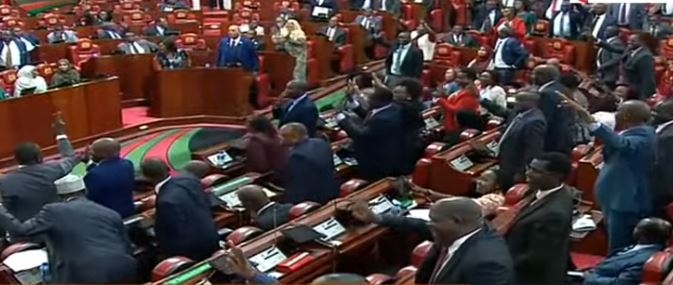
 Debt servicing has become a major expense, with Sh1.85 trillion set aside for the 2024/2025 fiscal year alone.
Debt servicing has become a major expense, with Sh1.85 trillion set aside for the 2024/2025 fiscal year alone.As Kenya’s public debt approaches the Sh12 trillion mark, concerns are growing that the strain is increasingly visible in workers’ payslips.
To plug financing gaps, the government has leaned heavily on borrowing, a move that has triggered ripple effects now landing directly in paychecks.
This is evident in higher deductions for projects alongside increased taxes meant to cover the widening budget deficit.
Debt servicing has become a major expense, with Sh1.85 trillion set aside for the 2024/2025 fiscal year alone.
MPs warn the outlook remains bleak, with obligations expected to rise to Sh2.47 trillion by June 2027.
In the current year, Sh1.87 trillion has already gone to debt repayment, keeping the revenue-to-debt ratio above 60 per cent.
Economists note that for every Sh100 the government collects, only Sh40 remains for operations, salaries, and development.
This pressure has directly shaped recent tax policies, particularly those targeting payrolls.
As debt costs consume more revenue, the government is forced to squeeze existing sources, including employment income.
Last fiscal year, repayments narrowed the spending room, pushing the government to prioritise debt over critical public services.
A recent Oxfam Kenya analysis warned that “the unsustainable public debt is slowing growth in Kenya,” arguing that essential services are losing out as funds are channelled to creditors.
The fallout, it said, is already hitting workers as the government seeks new ways to raise revenue.
Among the measures by President William Ruto’s Kenya Kwanza administration are higher payroll deductions through new levies and taxes.
Revised tax bands have also reduced take-home pay for many employees.
Auditor General Nancy Gathungu, in her latest review of government accounts, revealed that thousands of civil servants are now taking home barely a third of their pay.
She flagged ministries, state departments, and agencies where staff retain less than a third of their net income.
Her report shows 47,300 civil servants were affected in the year ending June 30, 2024.
Police were the worst hit, with 36,660 officers earning less than a third of their salary.
More than 550 Judiciary staff were in the same position, along with 1,275 in Immigration, 437 in Social Protection, 386 in Medical Services, and 222 in TVET.
Seeking to expand fiscal space, the government introduced new levies to finance housing projects, shortly after increasing deductions for medical insurance under the Social Health Insurance Fund (SHIF).
The housing levy is charged at 1.5 per cent of basic pay, matched by the employer, while SHIF contributions stand at 2.75 per cent.
Higher contributions to the National Social Security Fund (NSSF) have also been linked to the debt crisis. Minimum payments rose to Sh480, while high earners now remit up to Sh4,320 — a 100 per cent jump.
NSSF has been positioned as a state guarantor for mega projects that would otherwise rely on loans.
Kitui Central MP Makali Mulu, an economist, warned of tougher times ahead, saying payslips will continue to shrink unless the economy grows fast enough to bridge the gap.
“The payslip crisis is an indication that the economy is not doing well. We need to raise salaries to match up to the rate of inflation,” he said.
Civil servants, teachers, and public workers are among the hardest hit, especially those servicing mortgages.
They now face a double burden: higher taxes and the need to pay for private services amid shortfalls in public delivery.
The debt load has also created broader challenges for employers and payroll systems nationwide.
To manage the crisis, the government has rolled out several measures to stabilise revenue.
Experts recommend cutting government spending as a first step, alongside improving tax administration instead of raising tax rates.
They also urge debt restructuring and negotiations with creditors to ease servicing costs. For the average Kenyan employee, the debt problem continues to translate into a relentless squeeze on disposable income.















